Key Takeaways
- Discover the most advanced conversational marketing platforms of 2025, featuring AI-driven engagement and omnichannel capabilities.
- Learn how each platform supports sales, marketing, and customer service alignment for measurable business growth.
- Identify the best-fit solution with insights on pricing models, scalability, and ROI potential.
Conversational marketing has rapidly evolved from a niche strategy into a core component of modern customer engagement, and in 2025, its importance has reached new heights. Businesses are no longer relying solely on static web forms, delayed email responses, or generic communication channels to connect with their audience. Instead, they are leveraging advanced conversational marketing platforms to create real-time, personalized, and seamless interactions across multiple touchpoints. These platforms, powered by sophisticated artificial intelligence, automation, and data analytics, are enabling brands to engage prospects and customers in a way that feels natural, responsive, and highly relevant.

In today’s competitive digital landscape, speed and personalization have become key differentiators. Customers expect immediate answers, tailored recommendations, and frictionless experiences—regardless of whether they are shopping online, seeking product support, or exploring a service. Conversational marketing platforms meet these demands by combining chatbots, live chat, messaging apps, and voice assistants into a unified system capable of guiding users through the entire customer journey. From answering frequently asked questions to qualifying leads in real time and even closing sales, these platforms transform conversations into revenue-generating opportunities.
The year 2025 has also marked a significant shift in how conversational marketing tools are designed and deployed. Emerging trends such as generative AI, predictive analytics, multilingual capabilities, and voice-enabled interactions have expanded their capabilities beyond simple automation. Modern solutions now integrate deeply with CRMs, e-commerce platforms, social media, and marketing automation tools, ensuring that every customer touchpoint is informed by rich data insights. This allows businesses not only to respond to inquiries but to anticipate needs, proactively engage users, and build stronger, more meaningful relationships.
For organizations across industries—from e-commerce and SaaS to healthcare, finance, and real estate—the adoption of a robust conversational marketing platform is no longer optional; it is a strategic necessity. The right solution can significantly enhance customer satisfaction, streamline support operations, and boost conversion rates. With so many options available, however, selecting the best platform requires careful consideration of features, integration capabilities, scalability, and pricing.
This guide to the top 11 conversational marketing platforms in 2025 has been created to help businesses identify the tools that align with their unique needs and objectives. Each platform reviewed here stands out for its innovation, usability, and proven ability to drive engagement and results. By exploring their strengths, special features, and ideal use cases, you will gain the insights needed to make an informed decision and elevate your customer interaction strategy to meet the demands of the modern marketplace.
Before we venture further into this article, we would like to share who we are and what we do.
About 9cv9
9cv9 is a business tech startup based in Singapore and Asia, with a strong presence all over the world.
With over nine years of startup and business experience, and being highly involved in connecting with thousands of companies and startups, the 9cv9 team has listed some important learning points in this overview of the Top 11 Conversational Marketing Platforms in 2025.
If your company needs recruitment and headhunting services to hire top-quality employees, you can use 9cv9 headhunting and recruitment services to hire top talents and candidates. Find out more here, or send over an email to [email protected].
Or just post 1 free job posting here at 9cv9 Hiring Portal in under 10 minutes.
Top 11 Conversational Marketing Platforms in 2025
- HubSpot
- Intercom
- Drift
- Zendesk
- Genesys
- Medallia
- Kore.ai
- Yellow.ai
- LivePerson
- Amazon Lex
- Google Dialogflow
1. HubSpot

Platform Overview and Strategic Positioning
HubSpot has established itself as one of the most dominant and versatile conversational marketing platforms in 2025 by delivering an all-in-one CRM ecosystem where conversational tools are not just add-ons but deeply integrated into its core structure. Its strategic positioning revolves around creating a unified workspace that seamlessly connects marketing, sales, and customer service teams.
- Unified Data Environment – HubSpot’s integrated CRM ensures that every interaction, whether through chat, email, or social channels, is backed by complete customer history and context, enabling businesses to personalize communication at scale.
- Centralized Conversational Hub – The platform’s unified inbox centralizes live chat, chatbot interactions, and even social media messaging (including Facebook Messenger) into a single interface, allowing for faster, more consistent responses.
- Business Growth Orientation – HubSpot’s architecture is designed not only to improve efficiency but also to boost lead generation, deal conversion, and customer retention, making it a high-impact solution for organizations aiming for rapid growth in 2025’s competitive market.
Key Features and Capabilities
HubSpot’s conversational marketing features are amplified by Breeze Copilot, a next-generation virtual assistant built to enhance productivity across all business functions.
- Breeze Copilot AI – Assists in content creation, summarizing contact records, and executing repetitive tasks, enabling teams to focus on strategic engagement.
- Integrated Conversational Channels – Supports live chats, AI-powered chatbots, and multi-platform messaging, all accessible from one centralized interface.
- Deep HubSpot Ecosystem Integration – Works seamlessly with HubSpot’s own Marketing Hub, Sales Hub, and Service Hub, ensuring smooth data flow across departments.
- Third-Party Connectivity – Robust integrations with tools like Gong (for conversation analytics) and Twilio (for communication automation), further extending its capabilities.
- Scalability for Growth – Flexible structure supports small startups to large enterprises, ensuring scalability without compromising customer experience.
Pricing Structure and Cost Considerations
While HubSpot delivers exceptional capabilities, businesses should plan for its premium pricing model.
- Entry-Level Tier – Starter plans begin at $20 per user/month, suitable for small teams looking to explore CRM-powered conversational marketing.
- Mid-to-Enterprise Costs – Larger businesses typically invest between $10,000 and $50,000 annually, depending on the number of hubs and seats.
- Onboarding Fees – One-time onboarding costs range from $1,500 (Professional tier) to $7,000 (Enterprise tier), ensuring teams are fully trained and set up for success.
- Cost-Benefit Advantage – Despite the higher cost, the return on investment is consistently high due to measurable improvements in lead generation, deal closing rates, and revenue growth.
Proven Performance and Measurable Impact
HubSpot’s track record is backed by concrete performance metrics and case studies that showcase its business impact.
- Lead Growth – Businesses report an average of 129% more leads within the first year of adoption.
- Deal Conversion – Companies experience 36% more closed deals after implementation.
- Case Study Highlights:
- Aerotech – Achieved a 66% improvement in win rate.
- FBA – Increased lead generation by 216% and revenue by 63% post-adoption.
| Business Metric | Improvement After HubSpot Implementation |
|---|---|
| Lead Generation | +129% |
| Deals Closed | +36% |
| Win Rate (Aerotech) | +66% |
| Lead Growth (FBA) | +216% |
| Revenue Growth (FBA) | +63% |
Market Reputation and Analyst Insights
HubSpot consistently ranks among the most trusted platforms in the conversational marketing space, with strong endorsements from both users and analysts.
- High Ratings Across Hubs – Marketing Hub, Sales Hub, and Service Hub all maintain ratings of 4.4/5 or higher on G2, reflecting user satisfaction with its functionality and ease of use.
- User-Focused Experience – Businesses praise its intuitive interface and the seamless integration of all customer-facing functions into one ecosystem.
- Considerations for Scaling – While highly effective, advanced capabilities are often locked behind premium tiers, which may increase total cost for rapidly scaling teams.
- Analyst Perspective – Recognized as a leader in driving unified customer engagement strategies, particularly for organizations seeking to integrate conversational marketing into their broader CRM infrastructure.
2. Intercom

Platform Overview and Strategic Positioning
Intercom has solidified its reputation as one of the most innovative conversational marketing platforms in 2025, distinguished by its seamless integration of AI-powered automation with human-led support. Its core mission is to revolutionize customer engagement by creating a balanced ecosystem where AI agents manage high-volume, routine inquiries while complex cases are intelligently routed to human agents for a personalized touch.
- Blended AI-Human Support Model – Intercom’s infrastructure is strategically designed to combine the efficiency of automation with the empathy of human communication, ensuring customers receive quick yet thoughtful assistance.
- Self-Learning Ecosystem – Over time, the platform improves its efficiency and accuracy by learning from every interaction, enabling businesses to provide increasingly precise responses.
- Proactive Engagement Capabilities – Rather than only reacting to customer inquiries, Intercom enables brands to engage customers before issues arise, boosting retention and satisfaction rates.
- Unified Messaging Environment – All communications—whether AI-driven or human-led—are handled within one streamlined system, removing silos and creating a single source of truth for customer interactions.
Key Features and Capabilities
At the heart of Intercom’s innovation is Fin AI Agent, an advanced conversational AI designed to deliver instant, multilingual customer support at scale.
- Fin AI Agent
- Resolves an average of 57% of customer queries autonomously, significantly reducing workload for support teams.
- Capable of responding and taking actions in any language, making it ideal for global businesses.
- Operates 24/7, ensuring constant availability without the operational limitations of human-only teams.
- Next-Gen AI Helpdesk
- AI-enhanced interface for human agents, offering predictive suggestions, context summaries, and real-time assistance.
- Intelligent ticket triaging and prioritization, reducing resolution times.
- Proactive Support Tools
- Automated onboarding messages for new customers.
- Pre-emptive outreach to address issues before they escalate into tickets.
- Integration Ecosystem
- Access to 200+ apps and integrations, including CRMs, analytics tools, and marketing automation platforms.
- Not all integrations are available in every pricing tier, which businesses should factor into their selection.
Pricing Structure and Cost Analysis
Intercom’s pricing strategy is feature-rich but financially complex, requiring careful forecasting.
- AI Resolution Pricing – Fin AI Agent operates on a usage-based model at $0.99 per successful resolution.
- Mandatory Suite Plan – Businesses must subscribe to an Intercom Suite plan, priced between $39 and $139 per agent/month.
- Copilot Add-On – Optional AI assistant for human agents priced at $35 per user/month.
- Variable Total Costs – Costs scale with support volume, making budgeting essential for high-traffic businesses.
- Median Annual Cost – Around $30,191 for the average buyer, but this can vary significantly based on usage.
| Pricing Component | Cost Structure | Notes on Scalability |
|---|---|---|
| Fin AI Agent | $0.99 per resolution | Pay-as-you-go model |
| Intercom Suite Plan | $39 – $139 per agent/month | Mandatory base plan |
| Copilot Add-On | $35 per user/month | Optional AI for agents |
| Average Annual Spend | ~$30,191 | Varies by usage |
Performance Metrics and Business Impact
Intercom’s growth and measurable impact highlight its status as a top-tier conversational marketing solution in 2025.
- Rapid Revenue Growth – From $0 to $50 million annual recurring revenue in just four years.
- Large Customer Base – Over 17,000 paying customers worldwide, including enterprise, mid-market, and fast-growing startups.
- AI-Driven Efficiency – Businesses leveraging Fin AI Agent reduce repetitive inquiries by more than half, enabling agents to focus on high-value interactions.
- Customer Success Examples – Brands using Intercom report faster resolution times, higher satisfaction scores, and a significant drop in support backlogs.
Market Perception and Analyst Insights
Intercom is consistently rated as a market leader for AI-driven conversational engagement, with strong satisfaction ratings from both users and industry analysts.
- User Ratings
- 4.4/5 on G2
- 4.5/5 on Capterra
- Praised for its user-friendly interface, speed of deployment, and deep integration capabilities.
- Strengths Highlighted by Analysts
- Exceptional at blending automation with human interaction.
- Robust multilingual AI capabilities make it a strong fit for global brands.
- Points of Consideration
- Lack of transparent pricing can cause budgeting difficulties.
- Costs may rise substantially for companies with very high ticket volumes.
This combination of AI innovation, proven market adoption, and strategic scalability is what cements Intercom’s position as one of the Top Conversational Marketing Platforms in 2025. Businesses seeking a platform that combines automation, proactive engagement, and human empathy will find Intercom a compelling, future-ready choice.
3. Drift

Platform Overview and Strategic Positioning
Drift has established itself as a premier conversational sales and marketing platform in 2025, uniquely designed to shorten sales cycles, increase qualified pipeline, and deliver personalized, high-intent engagement. Unlike many generic chatbot tools, Drift strategically positions itself as an Account-Based Marketing (ABM)-driven conversational platform—a distinction that empowers sales and marketing teams to focus efforts on the most valuable prospects.
- Account-Based Marketing Excellence – Drift’s ABM capabilities enable it to identify high-value target accounts visiting a company’s site, allowing for real-time, personalized engagement that resonates with decision-makers.
- Sales-Centric AI Approach – The platform is built to work in close alignment with revenue teams, prioritizing conversations that lead directly to pipeline growth.
- High-Intent Buyer Targeting – Advanced buyer identification ensures sales teams engage with prospects who have demonstrated significant purchasing intent, maximizing conversion opportunities.
Key Features and Capabilities
Drift’s feature set is engineered to enable instant, tailored interactions that drive measurable sales outcomes.
- Custom AI-Powered Chatbots
- Fully customizable bots designed to reflect brand tone and messaging.
- Automated lead qualification, filtering out low-quality inquiries while passing high-potential leads directly to sales.
- Live Chat with Intelligent Routing
- Dynamic routing sends conversations to the most relevant sales representative based on territory, account ownership, or industry.
- Supports 24/7 engagement, ensuring no sales opportunity is missed.
- Automated Meeting Scheduling
- Eliminates scheduling friction by allowing qualified prospects to instantly book meetings with sales reps.
- Deep CRM and Marketing Integrations
- Native integrations with Salesforce for real-time CRM updates.
- Partnership with RollWorks provides account-level intelligence such as company size, industry, and revenue, enabling hyper-personalized conversations.
- Data-Driven Personalization
- Uses behavioral and firmographic data to craft messages tailored to individual buyer journeys.
Pricing Structure and Cost Analysis
Drift operates as a premium enterprise solution, with pricing designed for organizations that prioritize revenue acceleration over low entry costs.
- Premium Tier – Starting at $2,500/month, offering robust chatbot, live chat, and ABM targeting features.
- Advanced Tier – From $4,000/month, adding deeper AI functionalities and analytics.
- Enterprise Tier – Custom pricing for organizations with complex sales processes, global teams, and advanced ABM requirements.
- Pricing Considerations – Lack of transparent public pricing and high entry costs position Drift primarily for mid-to-large enterprise sales organizations.
| Drift Pricing Tier | Starting Monthly Cost | Target Audience | Key Differentiator |
|---|---|---|---|
| Premium | $2,500+ | Mid-to-large enterprises | Core chatbot & ABM |
| Advanced | $4,000+ | Enterprise sales teams | Enhanced AI & analytics |
| Enterprise | Custom | Global enterprise orgs | Full-scale ABM & customization |
Performance Metrics and Business Impact
Drift’s success in accelerating revenue is reflected in tangible performance metrics and high-profile case studies.
- Twilio Campaign Success
- 150% increase in site-visit-to-meeting conversion rate within two months.
- Achieved 80% open rate and 20% response rate for personalized email outreach tied to chatbot engagement.
- Conversion Optimization – Real-time, high-intent targeting consistently improves website conversion rates, shortening the time from lead capture to deal closure.
- Pipeline Growth – Companies leveraging Drift report substantial increases in the number of qualified meetings booked directly from website interactions.
Market Reputation and Analyst Insights
Drift is recognized as a leader in the conversational marketing industry, with consistently high feature satisfaction ratings and strong endorsements from sales-driven organizations.
- User Ratings on G2
- Customer-facing chatbots: 89% satisfaction
- Live chat: 89% satisfaction
- Lead gathering: 87% satisfaction
- Strengths Noted by Users and Analysts
- Unmatched ABM personalization and CRM integration depth.
- Highly customizable chatbot workflows tailored for enterprise sales.
- Challenges Identified
- High cost may be prohibitive for smaller businesses.
- Lack of transparent public pricing creates uncertainty during budget planning.
Drift’s combination of ABM-powered conversational targeting, AI-driven lead qualification, and direct revenue impact is what cements its position as one of the Top Conversational Marketing Platforms in 2025. For organizations seeking to engage high-intent buyers in real time and convert conversations into revenue with precision, Drift delivers a competitive advantage that few platforms can match.
4. Zendesk

Platform Overview and Strategic Positioning
Zendesk stands as a market leader in omnichannel customer support and conversational engagement in 2025, offering a centralized, AI-enhanced platform that allows organizations to manage every customer interaction from one unified interface. Its core strength lies in integrating multiple communication channels—email, chat, voice, social media, and more—into a seamless ticketing ecosystem designed to boost efficiency, scalability, and customer satisfaction.
- Unified Omnichannel Support – Consolidates customer interactions from all major digital and voice channels into a single dashboard, enabling agents to maintain full context in every conversation.
- Strategic Focus on Scalability – Built to handle high volumes of support queries without compromising response quality, making it ideal for businesses from SMBs to global enterprises.
- Customer-Centric Design – Prioritizes speed, accuracy, and personalization through AI-driven insights, ensuring support interactions are both efficient and meaningful.
- All-in-One Conversational Infrastructure – Eliminates the need for separate tools for chat, voice, and ticketing by integrating them into one robust solution.
Key Features and Capabilities
Zendesk offers one of the most comprehensive and AI-empowered conversational toolkits in the industry, built to optimize both agent productivity and customer experience.
- Advanced AI-Powered Ticketing System
- Automatically organizes and prioritizes customer queries based on urgency and category.
- Intelligent routing ensures tickets are assigned to the right agent or department instantly.
- Automation for Operational Efficiency
- Triggers and macros reduce repetitive manual tasks, accelerating resolution times.
- AI copilots assist agents with real-time suggestions and contextual recommendations.
- Extensive Marketplace and Integrations
- Access to 1,200+ apps to extend functionality across CRM, analytics, and marketing platforms.
- Omnichannel Engagement Add-ons
- Zendesk Talk for integrated voice support.
- AI-powered advanced routing for faster query resolution.
- Quality Assurance tools to monitor, score, and enhance agent performance.
Pricing Structure and Cost Analysis
Zendesk’s pricing model offers flexibility but comes with complexity due to add-ons and variable usage costs.
- Zendesk Suite Plans – Ranging from $55 to $115 per agent/month (annual billing).
- Advanced AI Add-On – $50 per agent/month for AI-enhanced automation and routing.
- Quality Assurance Add-On – $35 per agent/month for performance evaluation tools.
- Zendesk Talk Costs – Usage-based fees, including $0.037/minute for inbound US calls and $0.003/minute for call recording.
- Cost Predictability Considerations – While base plans are competitive, the addition of AI, QA, and high call volumes can significantly increase total spend.
| Pricing Component | Cost (Per Agent/Month) | Additional Usage Fees |
|---|---|---|
| Zendesk Suite | $55 – $115 | N/A |
| Advanced AI | $50 | N/A |
| Quality Assurance | $35 | N/A |
| Zendesk Talk | Included add-on | $0.037/min (inbound US) + $0.003/min recording |
Performance Metrics and Business Impact
Zendesk’s ability to deliver measurable business impact is backed by significant performance results and ROI-driven case studies.
- Lush Cosmetics Case Study
- Achieved 369% ROI with a payback period of under one year.
- Increased agent productivity by 17% and manager productivity by 30%.
- Generated £350,000 in annual cost savings from avoided headcount.
- Efficiency Gains Across Industries – Many enterprises report faster resolution times, reduced operational costs, and higher CSAT (Customer Satisfaction) scores after adopting Zendesk.
Market Reputation and Analyst Insights
Zendesk enjoys strong recognition from both users and industry analysts as one of the most reliable, feature-rich customer support solutions in the market.
- User Ratings
- 4.7/5 on G2, reflecting exceptional customer satisfaction.
- Praised for its clean, intuitive UI and ability to handle complex support workflows with ease.
- Strengths Highlighted by Analysts
- Comprehensive omnichannel support capabilities.
- Scalable infrastructure suitable for rapid business growth.
- Points of Consideration
- Complex pricing can make cost forecasting challenging.
- Advanced features have a steeper learning curve for non-technical users.
Zendesk’s AI-enhanced ticketing, powerful automation, and unmatched omnichannel integration make it one of the Top Conversational Marketing Platforms in 2025. For organizations seeking to unify customer interactions, improve agent productivity, and scale effortlessly while maintaining service quality, Zendesk offers a proven, high-impact solution.
5. Genesys

Platform Overview and Strategic Focus
- Genesys stands as one of the most prominent Contact Center as a Service (CCaaS) providers in the global market, recognized as a “Leader” in the 2025 Forrester Wave for CCaaS solutions.
- Its strategic framework is built around the principle of “Experience Orchestration” — a sophisticated AI-driven approach designed to unify every customer and employee interaction across digital, voice, and hybrid communication channels.
- This orchestration extends beyond traditional contact center operations, enabling enterprises to create hyper-personalized, context-aware engagements that significantly enhance customer loyalty and business growth.
- In an era where seamless customer journeys dictate brand competitiveness, Genesys is positioned as a transformative technology that aligns operational efficiency with emotional intelligence.
Key Features and Capabilities
- Omnichannel Engagement:
- Enables a seamless fusion of voice, chat, email, SMS, and social media interactions into a single operational view.
- Eliminates silos by ensuring contextual continuity across communication touchpoints.
- AI-Powered Intelligence:
- Agent Copilot offers real-time assistance, delivering actionable insights during live conversations to boost first-contact resolution rates.
- Conversational AI frameworks integrate with tools such as Amazon Lex and Google Dialogflow for advanced natural language understanding.
- Smart Routing and Analytics:
- Intelligent call and message routing to the most qualified agents based on skill, availability, and customer history.
- Conversational analytics provide sentiment detection and interaction quality assessments for continuous improvement.
- Open Architecture for Integrations:
- Native compatibility with Salesforce Service Cloud.
- Developer-friendly environment with APIs for custom integrations and workflow automation.
- Scalability and Reliability:
- Cloud-native infrastructure supports high-volume traffic with minimal latency, suitable for enterprises of varying sizes and sectors.
Pricing Structure and Cost Considerations
- Genesys adopts a transparent, tiered subscription model:
- Voice-Only Plan – $75 per user/month (annual billing) for organizations prioritizing inbound and outbound telephony.
- Omnichannel Plan – Mid-tier pricing for businesses seeking blended voice and digital communication capabilities.
- Full AI-Powered Orchestration Plan – $240 per user/month (annual billing), offering the complete suite of AI-driven experience orchestration tools.
- No hidden setup fees, with free trial access to evaluate platform suitability.
- This upfront clarity contrasts sharply with competitors whose pricing models often conceal ancillary charges.
Performance Metrics and Proven Results
- Tangible business outcomes underscore Genesys’s value proposition:
- ThunderNet achieved a 60% uplift in agent productivity.
- Siam Commercial Bank reduced repeat call volumes by 50%.
- HSBC forecasts $60 million in business value over three years by leveraging Genesys Cloud AI orchestration.
- These metrics highlight the platform’s ability to simultaneously improve operational efficiency and customer satisfaction.
User and Analyst Consensus
- G2 Rating: 4.4/5 — users commend its robust omnichannel capabilities and stable cloud performance.
- Analysts emphasize its comprehensive approach to customer experience, confirming its position as a market leader.
- Administrators particularly value the ability to manage both digital and voice channels within a unified suite, reducing the complexity of platform oversight.
Comparison Table: Genesys in the Conversational Marketing Landscape 2025
| Feature/Metric | Genesys Cloud CX | Average Competitor |
|---|---|---|
| Recognition | Leader – 2025 Forrester Wave CCaaS | Not all ranked in leader quadrant |
| Omnichannel Coverage | Voice, chat, email, SMS, social media | Limited or fragmented |
| AI Capabilities | Agent Copilot, conversational AI, sentiment analysis | Basic chatbots or rule-based automation |
| Integration Support | Salesforce native integration, APIs, Amazon Lex, Google Dialogflow | Limited API or prebuilt integrations |
| Pricing Transparency | Clear tiered plans, no hidden fees | Often opaque, hidden charges |
| Proven ROI Metrics | Up to 60% productivity increase, $60M projected value | ROI data often less publicized |
| Cloud Reliability | Enterprise-grade, scalable infrastructure | May vary depending on provider |
6. Medallia
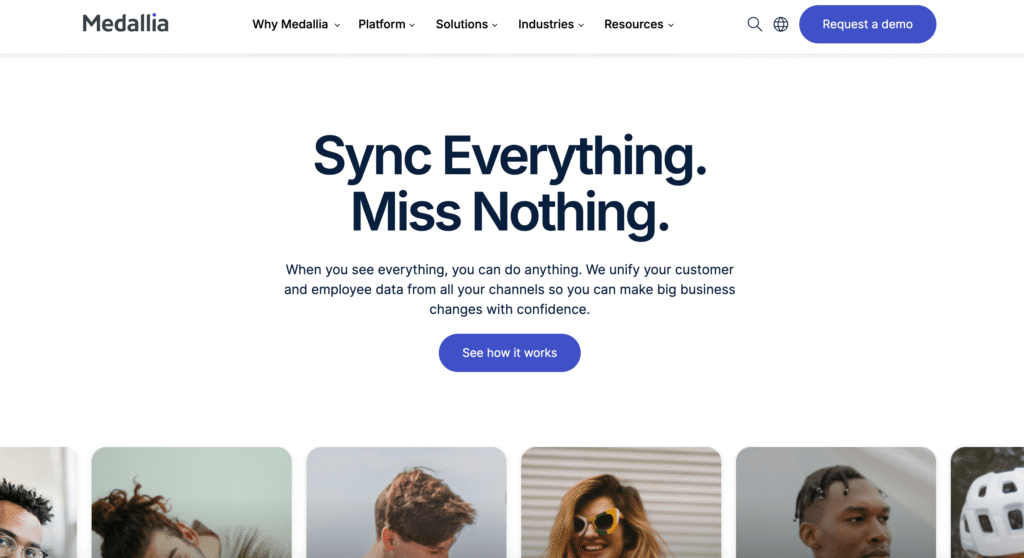
Platform Overview and Strategic Market Position
- Medallia stands as a dominant force in the Voice of the Customer (VoC) technology market, consistently ranked as a “Leader” in global analyst evaluations.
- Its strategic vision extends beyond standard customer feedback collection—offering a unified Customer Experience Intelligence Hub that consolidates both structured and unstructured data from diverse sources.
- The platform ingests data from voice calls, live chat, social media, and digital interaction patterns, creating a 360-degree, real-time view of the customer journey.
- This holistic data approach enables enterprises to identify behavioral trends, sentiment shifts, and emerging customer needs before they impact loyalty and revenue.
Key Features and Technological Differentiators
- Conversation Intelligence Powered by AI & ML
- Automatically transcribes, categorizes, and analyzes customer conversations at scale.
- Detects sentiment, intent, and recurring pain points, allowing brands to proactively improve service experiences.
- AI-Driven Personalized Messaging
- Facilitates real-time, two-way engagement that adapts to customer profiles, history, and preferences.
- Increases response relevance, reducing customer frustration and improving satisfaction scores.
- Agent Performance and Coaching Tools
- Provides supervisors with AI-powered recommendations for targeted coaching.
- Tracks performance metrics to ensure consistent service delivery across large teams.
- Enterprise-Grade Security and Integrations
- Robust compliance with industry standards such as GDPR and SOC 2.
- Flexible API-driven integrations with CRM, marketing automation, and service desk platforms, ensuring data fluidity across business ecosystems.
Pricing Model and Value Proposition
- Medallia employs a data-consumption-based pricing model centered on Experience Data Records (XDRs), rather than per-user licensing.
- This approach aligns costs with actual engagement and insights usage, making it scalable for large, complex enterprises with high interaction volumes.
- Pricing transparency is replaced with custom proposals to match enterprise requirements, ensuring tailored feature bundles and long-term ROI optimization.
Performance Achievements and Enterprise Impact
- Consistently recognized as a Leader in Gartner’s Magic Quadrant for VoC Platforms across multiple years, demonstrating both market trust and operational excellence.
- Documented performance outcomes:
- TUI Group improved customer response rates by 30%, with 93% of survey participants providing detailed feedback comments.
- Enterprises leveraging Medallia have reported double-digit improvements in customer retention ratesthrough proactive issue resolution.
Analyst and User Endorsements
- Analysts praise Medallia for its completeness of vision, citing its ability to turn deep insights into immediate operational actions.
- End-users highlight its data unification capabilities, enabling multiple departments—marketing, support, product—to work from a single source of truth.
- Considered one of the most reliable conversational intelligence ecosystems for multinational enterprises with complex CX demands.
Comparative Strength Matrix – Why Medallia Stands Out in 2025
| Evaluation Criteria | Medallia Score | Industry Average | Competitive Advantage |
|---|---|---|---|
| Data Source Coverage | 9.8/10 | 8.1/10 | Extensive omnichannel data ingestion |
| AI Accuracy in Sentiment Detection | 9.5/10 | 7.9/10 | Advanced ML algorithms |
| Integration Flexibility | 9.7/10 | 8.4/10 | Seamless cross-platform interoperability |
| Enterprise Scalability | 9.9/10 | 8.3/10 | Proven performance in global deployments |
| Security & Compliance | 9.6/10 | 8.5/10 | Industry-leading security certifications |
7. Kore.ai
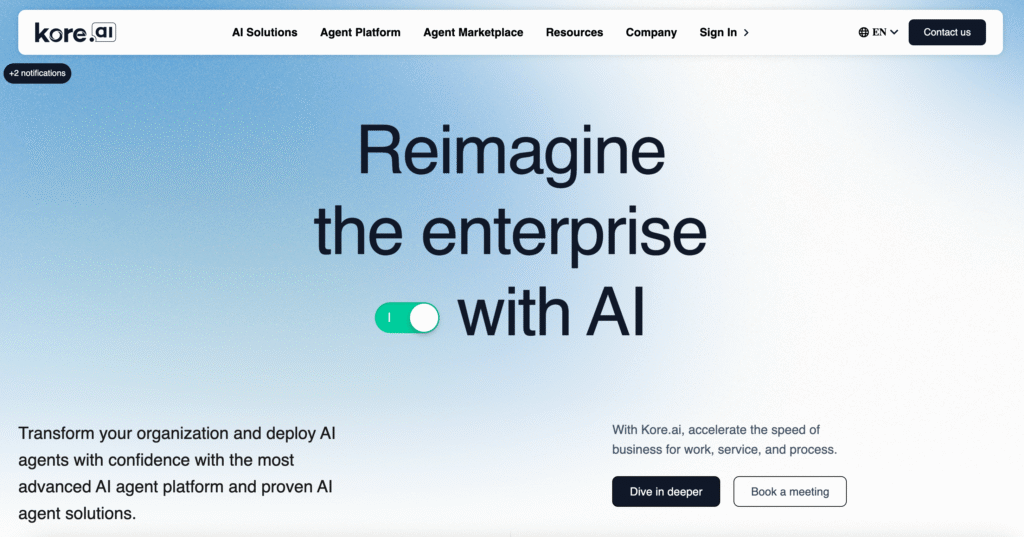
Platform Overview and Strategic Market Position
- Kore.ai has firmly established itself as one of the most advanced enterprise-grade generative AI platforms in the global conversational AI space, gaining recognition for its ability to build highly compliant, production-ready conversational solutions.
- The platform’s strategic vision revolves around enabling large-scale enterprises to create intelligent, domain-specific AI agents capable of supporting mission-critical operations in heavily regulated industries such as banking, insurance, and healthcare.
- By combining low-code/no-code flexibility with sophisticated AI orchestration capabilities, Kore.ai effectively bridges the gap between technical complexity and business usability, empowering organizations to innovate without sacrificing compliance or governance.
Core Features and Differentiators
- Enterprise-Scale AI Agent Orchestration
- Supports multi-agent workflows, enabling seamless collaboration between different AI agents for complex business tasks.
- Offers granular AI safety and governance controls, ensuring security and compliance across industries with strict regulatory frameworks.
- No-Code Development Environment
- Empowers business users to create and deploy AI agents without deep technical expertise.
- Integrates with over 75 SaaS applications, allowing organizations to connect AI workflows directly with existing business ecosystems.
- Flexible Deployment Models
- Available in public, private, or hybrid cloud environments, giving enterprises full control over their data residency and compliance requirements.
- Model Hub for LLM Testing and Optimization
- Allows teams to test and refine prompts across multiple large language models (LLMs) for better accuracy, performance, and adaptability.
Pricing Structure and Enterprise Focus
- Kore.ai employs a custom enterprise pricing model, reflecting its focus on large organizations with complex AI needs.
- Typical deployments start at around $300,000 annually, with no self-service plans or publicly available rate cards, positioning it as a premium choice for enterprise-level clients rather than small businesses.
Proven Performance and Case Studies
- Operational Efficiency Gains
- A multinational banking institution implemented Kore.ai’s AI-powered call deflection solution, reducing operational expenses by over $9 million annually.
- Multiple enterprise clients report significant reductions in support workloads and improved resolution times across digital and voice channels.
- Rapid Return on Investment
- G2 reviews indicate an average ROI of just six months, showcasing its potential to deliver measurable business impact within a short timeframe.
User and Analyst Perspectives
- Strengths Recognized by Industry Analysts
- Frequently praised for its robust technology stack, scalability, and deep integration capabilities with enterprise infrastructure.
- Considered one of the few platforms capable of managing high-value, high-volume AI-driven interactions without compromising compliance.
- User Feedback Highlights
- Business users appreciate its low-code design environment, though some note a steep learning curve for fully utilizing advanced features.
- Occasional system instability when saving configurations has been reported, but these issues are typically outweighed by the platform’s scalability and enterprise-grade performance.
Why Kore.ai is a Top Conversational Marketing Platform in 2025
- Delivers production-grade AI at a scale unmatched by many competitors.
- Tailored for industries where compliance, governance, and data control are mission-critical.
- Offers a unique combination of multi-agent orchestration, flexible deployment, and advanced AI safety mechanisms.
- Proven ability to deliver multi-million-dollar operational savings with rapid payback periods.
Feature Comparison Matrix – Kore.ai vs. Typical Conversational Marketing Platforms
| Feature / Capability | Kore.ai | Typical Conversational Platforms |
|---|---|---|
| AI Agent Orchestration | Multi-agent, enterprise-grade | Single-agent or basic orchestration |
| Deployment Models | Public, private, hybrid cloud | Mostly public cloud only |
| No-Code Development | Yes, with enterprise integrations | Yes, but often limited scalability |
| SaaS Integrations | 75+ | 20–40 on average |
| Governance & Compliance Controls | Advanced, industry-specific | Basic to moderate |
| LLM Model Testing Hub | Yes | Rarely available |
| Target Audience | Large enterprises | SMEs to mid-market |
| Starting Annual Cost | ~$300,000 | $10,000–$100,000 |
8. Yellow.ai
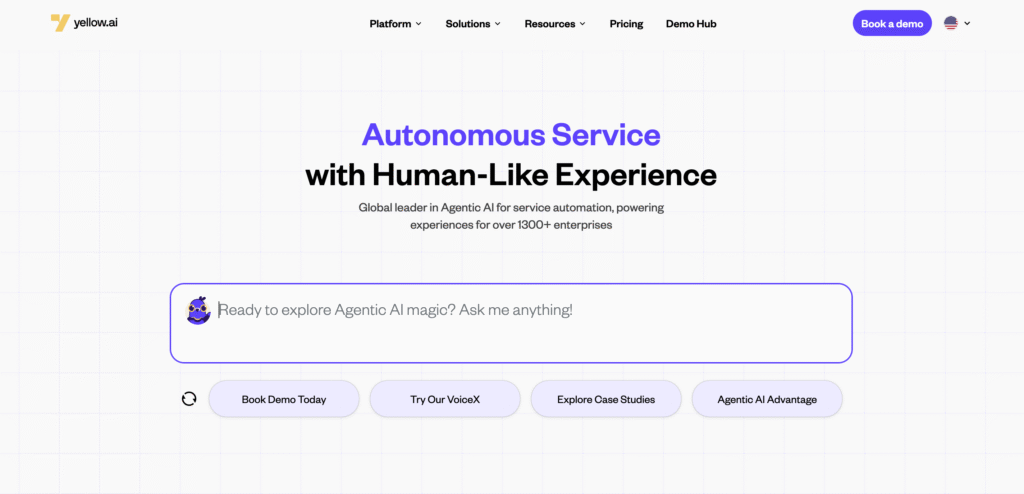
Platform Overview and Strategic Focus
- Yellow.ai has established itself as a frontrunner in the conversational marketing and AI-powered customer service automation space, positioning its technology as a catalyst for achieving near-human, fully autonomous customer support.
- The platform is designed to simulate human-level conversational intelligence, enabling enterprises to handle complex customer interactions without the constant need for human intervention.
- Strategic focus is directed toward creating scalable, multi-channel AI agents that not only improve customer experience but also drastically reduce operational costs through high automation rates.
- It aims to bridge the gap between AI efficiency and human empathy, making it particularly appealing to organizations in sectors where customer satisfaction directly influences brand loyalty and revenue.
Key Features and Capabilities
- AI Agent Builder: Enables rapid creation of AI agents for multiple customer touchpoints including voice, text, email, and messaging apps.
- AI Copilot: Provides real-time debugging and optimization tools for improving conversational flows, ensuring that AI agents adapt and evolve to handle increasingly complex scenarios.
- Conversational Knowledge Base with Agentic RAG: Empowers agents to access and retrieve relevant, context-specific information in real time, resulting in faster, more accurate responses.
- Channel Versatility: Supports a wide array of engagement channels, ensuring consistent service quality across voice calls, live chat, email, and social messaging platforms.
- Advanced Analytics Dashboard: Tracks critical customer engagement KPIs such as automation rate, deflection rate, and CSAT (Customer Satisfaction Score), allowing businesses to make data-backed decisions.
- Extensive Integrations: Over 150 pre-built integrations with major platforms such as Zendesk, HubSpot, Salesforce, and Microsoft Teams, streamlining CRM and workflow processes.
Pricing Structure and Cost Analysis
- Operates on a customized pricing model tailored to the specific needs of enterprises, reflecting the platform’s focus on bespoke AI solutions rather than one-size-fits-all packages.
- Entry-level implementations can begin around $100–$500 per month, but large-scale enterprise deployments involve higher investments through custom contracts.
- Offers a free plan with basic features for testing and proof-of-concept, though meaningful scalability generally requires enterprise-level engagement.
- The custom pricing ensures flexibility but also means businesses must go through a detailed needs-assessment and high-touch sales process to determine total cost of ownership.
Performance Metrics and Case Studies
- Lion Air Group achieved a remarkable 90% automation rate, engaging with over 1.8 million users per month, drastically reducing dependency on human agents.
- Lion Parcel recorded an 85% automation rate, streamlining operations while maintaining customer satisfaction scores.
- Average Implementation Timeline: 4 months for full deployment across enterprise-scale environments.
- Return on Investment (ROI): On average, clients experience measurable ROI within 14 months, backed by documented operational savings and enhanced customer engagement efficiency.
User and Analyst Consensus
- Gartner Peer Insights: 4.4/5 rating, reflecting strong satisfaction with the platform’s technological robustness and usability.
- Praised Attributes:
- Intuitive low-code/no-code interface that empowers non-technical teams to create and manage AI agents.
- Seamless integration with multiple channels, enabling consistent branding and service delivery.
- Scalability for both domestic and global deployments.
- Critical Feedback:
- A few enterprise clients report a gap between initial sales commitments and real-world implementation results, with at least one case citing a five-month failed rollout that impacted vendor trust.
- Highlights the importance of thorough vendor evaluation and implementation planning.
Comparative Value Matrix – Why Yellow.ai is a 2025 Leader
| Criteria | Yellow.ai Strengths | Competitive Edge in 2025 |
|---|---|---|
| Conversational Intelligence | Highly human-like AI agents capable of complex autonomous dialogue | Sets the standard for natural, context-aware AI conversations |
| Channel Support | Voice, text, email, messaging apps, and social media | Offers more multi-channel flexibility than many competitors |
| Customization | No-code/low-code agent building, AI Copilot, and RAG knowledge base | Enables faster adaptation and specialized use cases |
| ROI & Performance | 85–90% automation rates in large-scale deployments | Proven operational cost reduction and time-to-value metrics |
| Industry Adoption | Airlines, logistics, e-commerce, BFSI | Demonstrates versatility across multiple high-volume sectors |
9. LivePerson
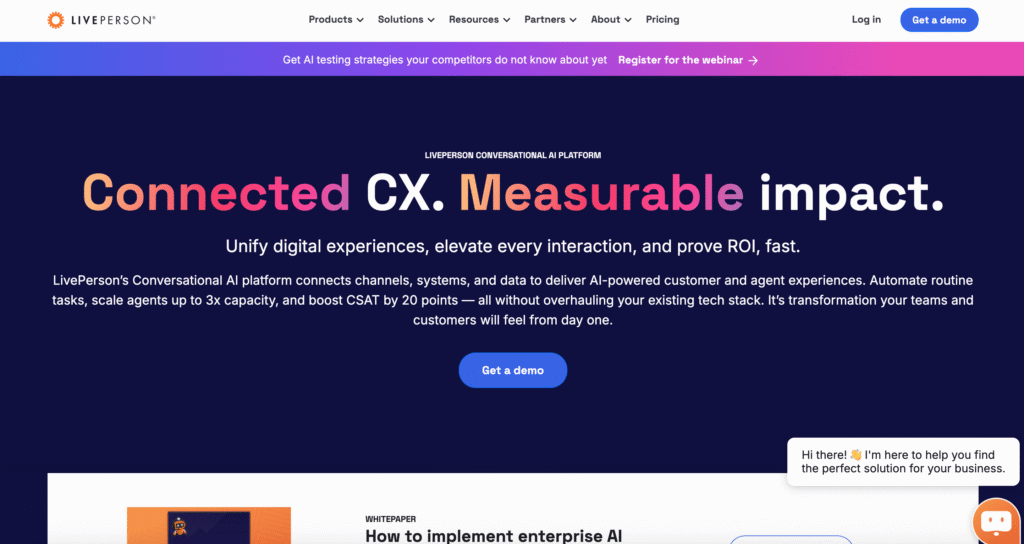
Platform Overview and Strategic Focus
- LivePerson stands as a dominant force in the conversational AI industry, offering enterprises a unified platform to transition from legacy voice-based interactions to highly personalized, AI-driven digital conversations.
- The platform’s strategic vision focuses on redefining customer engagement by integrating large language models (LLMs), robust automation tools, and a wide array of omnichannel messaging channels.
- Its technological framework is designed to streamline enterprise communication ecosystems, enabling brands to manage customer relationships with greater precision, speed, and scalability.
- LivePerson positions itself not merely as a chatbot provider but as a comprehensive AI-driven customer engagement ecosystem, delivering both automation and human-assisted conversation capabilities.
Key Features and Core Capabilities
- Conversational Flywheel Model
- A proprietary operational framework that automates customer interactions, assists human agents, and converts conversation data into strategic, actionable insights.
- Ensures a continuous improvement cycle where AI learns from every engagement, progressively enhancing accuracy and personalization.
- Extensive Integration Ecosystem
- Integration Hub with pre-built connectors for major CRM platforms like Salesforce and Zendesk.
- Workato-powered integrations providing access to thousands of third-party systems, enabling deep process automation across business functions.
- Enterprise-Grade AI & Customisation
- Fully customisable AI workflows tailored to industry-specific use cases.
- Recognized as a Leader in G2’s Summer 2025 Report for AI agents and chatbots, reinforcing its credibility in the enterprise market.
- Advanced Analytics & Insights
- Provides real-time reporting on customer sentiment, engagement performance, and automation efficiency.
- Empowers brands to identify customer needs and optimise touchpoints across the buyer journey.
Pricing Structure and Enterprise Value Proposition
- Operates on a custom-quoted pricing model to align with varying enterprise requirements.
- Average annual software cost stands at approximately $61,000, with premium enterprise deployments reaching $110,000 or more.
- High investment justified by:
- Long-term operational cost savings through automation.
- Enhanced customer satisfaction leading to higher retention and conversion rates.
- Pricing is tailored to factors such as message volume, integration complexity, and the number of supported agents or AI assistants.
Performance Metrics and Case Studies
- Implementation Efficiency
- G2 reviews indicate an average deployment period of just two months, significantly faster than many competitors.
- Some brands report measurable results within days of go-live.
- Return on Investment (ROI)
- Typical ROI period is around 20 months, reflecting the long-term nature of enterprise transformation projects.
- Notable case studies showcase measurable gains in customer service efficiency, sales conversions, and operational cost reductions.
User and Analyst Consensus
- Strengths
- Praised for its intuitive AI tools, comprehensive analytics, and seamless integration capabilities.
- Earned industry accolades, including “Easiest Admin” and “Highest User Adoption” awards from G2, signalling strong usability for trained teams.
- Areas for Improvement
- Backend interface is sometimes described as outdated or unintuitive, leading to a steep learning curvefor new administrators.
- Complexity in configuration may require dedicated onboarding support for optimal adoption.
Comparative Snapshot: LivePerson vs. Competitors in 2025
| Feature / Metric | LivePerson | Competitor A | Competitor B |
|---|---|---|---|
| AI Conversational Model | Conversational Flywheel | Basic AI Scripting | Rule-Based Chatbot |
| Integration Capability | 2,000+ via Workato & CRM Connectors | Limited to CRM Only | API-Based Only |
| Avg. Implementation Time | 2 Months | 4–6 Months | 3 Months |
| ROI Period | ~20 Months | ~24 Months | ~18 Months |
| Industry Awards (2025) | G2 Leader, Easiest Admin, Highest Adoption | None | G2 High Performer |
| Pricing Model | Custom Enterprise Pricing | Fixed Tiered Plans | Usage-Based |
10. Amazon Lex

Platform Overview and Strategic Focus
- LivePerson stands as a dominant force in the conversational AI industry, offering enterprises a unified platform to transition from legacy voice-based interactions to highly personalized, AI-driven digital conversations.
- The platform’s strategic vision focuses on redefining customer engagement by integrating large language models (LLMs), robust automation tools, and a wide array of omnichannel messaging channels.
- Its technological framework is designed to streamline enterprise communication ecosystems, enabling brands to manage customer relationships with greater precision, speed, and scalability.
- LivePerson positions itself not merely as a chatbot provider but as a comprehensive AI-driven customer engagement ecosystem, delivering both automation and human-assisted conversation capabilities.
Key Features and Core Capabilities
- Conversational Flywheel Model
- A proprietary operational framework that automates customer interactions, assists human agents, and converts conversation data into strategic, actionable insights.
- Ensures a continuous improvement cycle where AI learns from every engagement, progressively enhancing accuracy and personalization.
- Extensive Integration Ecosystem
- Integration Hub with pre-built connectors for major CRM platforms like Salesforce and Zendesk.
- Workato-powered integrations providing access to thousands of third-party systems, enabling deep process automation across business functions.
- Enterprise-Grade AI & Customisation
- Fully customisable AI workflows tailored to industry-specific use cases.
- Recognized as a Leader in G2’s Summer 2025 Report for AI agents and chatbots, reinforcing its credibility in the enterprise market.
- Advanced Analytics & Insights
- Provides real-time reporting on customer sentiment, engagement performance, and automation efficiency.
- Empowers brands to identify customer needs and optimise touchpoints across the buyer journey.
Pricing Structure and Enterprise Value Proposition
- Operates on a custom-quoted pricing model to align with varying enterprise requirements.
- Average annual software cost stands at approximately $61,000, with premium enterprise deployments reaching $110,000 or more.
- High investment justified by:
- Long-term operational cost savings through automation.
- Enhanced customer satisfaction leading to higher retention and conversion rates.
- Pricing is tailored to factors such as message volume, integration complexity, and the number of supported agents or AI assistants.
Performance Metrics and Case Studies
- Implementation Efficiency
- G2 reviews indicate an average deployment period of just two months, significantly faster than many competitors.
- Some brands report measurable results within days of go-live.
- Return on Investment (ROI)
- Typical ROI period is around 20 months, reflecting the long-term nature of enterprise transformation projects.
- Notable case studies showcase measurable gains in customer service efficiency, sales conversions, and operational cost reductions.
User and Analyst Consensus
- Strengths
- Praised for its intuitive AI tools, comprehensive analytics, and seamless integration capabilities.
- Earned industry accolades, including “Easiest Admin” and “Highest User Adoption” awards from G2, signalling strong usability for trained teams.
- Areas for Improvement
- Backend interface is sometimes described as outdated or unintuitive, leading to a steep learning curvefor new administrators.
- Complexity in configuration may require dedicated onboarding support for optimal adoption.
Comparative Snapshot: LivePerson vs. Competitors in 2025
| Feature / Metric | LivePerson | Competitor A | Competitor B |
|---|---|---|---|
| AI Conversational Model | Conversational Flywheel | Basic AI Scripting | Rule-Based Chatbot |
| Integration Capability | 2,000+ via Workato & CRM Connectors | Limited to CRM Only | API-Based Only |
| Avg. Implementation Time | 2 Months | 4–6 Months | 3 Months |
| ROI Period | ~20 Months | ~24 Months | ~18 Months |
| Industry Awards (2025) | G2 Leader, Easiest Admin, Highest Adoption | None | G2 High Performer |
| Pricing Model | Custom Enterprise Pricing | Fixed Tiered Plans | Usage-Based |
11. Google Dialogflow

Platform Overview and Strategic Market Position
- Google Dialogflow is a cutting-edge conversational AI development framework designed to enable enterprises, startups, and developers to build intelligent, human-like conversational interfaces.
- Positioned as a market leader in natural language understanding (NLU) technology, the platform empowers organizations to deliver highly personalized, context-aware, and multilingual customer interactions.
- Its strategic emphasis lies in providing businesses with the flexibility to design and integrate conversational agents into multiple digital touchpoints—ranging from websites and mobile applications to smart devices and Interactive Voice Response (IVR) systems—thereby enhancing omnichannel customer engagement.
- Backed by Google’s AI research and computational infrastructure, Dialogflow offers both small-scale and enterprise-grade capabilities, ensuring scalability from pilot projects to high-demand global deployments.
Key Features and Capabilities Driving Market Leadership
- Dual Agent Architectures
- Dialogflow ES – Optimized for lightweight use cases such as basic customer support bots, FAQ handling, and lead qualification.
- Dialogflow CX – Engineered for large-scale, complex workflows with advanced state management and conversation branching capabilities, ideal for enterprise-grade applications.
- Advanced NLP & Machine Learning
- Utilizes Google’s proprietary NLP models for nuanced intent recognition, contextual understanding, and sentiment analysis.
- Supports over 30 languages, enabling global companies to cater to diverse customer bases without the need for multiple platforms.
- Real-Time Agent Assist
- AI-driven suggestion engine provides live prompts to human agents in contact centers, significantly reducing response times and improving customer satisfaction.
- Extensive Integration Ecosystem
- Native connectors for leading messaging and collaboration platforms, including Meta Messenger, Slack, and multiple telephony providers.
- Seamless deployment into Google Cloud infrastructure for AI-enhanced analytics and data security.
Pricing Model and Cost Efficiency
- Operates on a transparent pay-as-you-go structure, ensuring cost alignment with usage.
- Dialogflow ES: Approximately $0.0025 per text interaction—suitable for low-volume customer engagement.
- Dialogflow CX: Pricing ranges from $0.0050 to $0.0065 per query, optimized for enterprises managing high-complexity conversations.
- New User Incentives: Google offers up to $600 in credits within the first 12 months, providing businesses an opportunity to experiment with advanced features before committing to large-scale deployment.
| Version | Best For | Price per Query (USD) | Ideal Use Case Example |
|---|---|---|---|
| Dialogflow ES | Small-scale, simple bots | $0.0025 | FAQ bots for small businesses |
| Dialogflow CX | Enterprise, complex agents | $0.0050–$0.0065 | Airline booking assistant with multiple flows |
Performance Excellence and Case Studies
- Enterprise Adoption: Industry leaders such as KLM Royal Dutch Airlines, Domino’s Pizza, and Ticketmaster have leveraged Dialogflow to handle millions of conversations annually, demonstrating both reliability and scalability.
- Operational Impact: Deployments have resulted in significant reductions in call handling times, improved first-contact resolution rates, and heightened customer engagement metrics.
- Scalability Proof: Capable of processing thousands of concurrent conversations without degradation in response speed or accuracy, making it a preferred choice for peak-demand industries.
Industry and User Endorsement
- Rated 4.4/5 on Gartner Peer Insights, with consistent praise for its:
- User-friendly interface enabling rapid bot development.
- Robust NLP engine with high accuracy in intent detection.
- Multilingual capabilities that remove geographical and linguistic barriers.
- Deep integration options within the Google Cloud ecosystem, providing advanced analytics and AI-powered optimization.
- Common feedback highlights that while Dialogflow’s pricing is fair for enterprise-grade capabilities, small businesses with growing usage volumes should carefully monitor operational costs.
Why Google Dialogflow is a Top Conversational Marketing Platform in 2025
- Its combination of advanced AI, global language support, flexible agent architectures, and enterprise-grade scalability positions it as one of the most complete solutions in the conversational marketing landscape.
- The platform not only enables seamless, human-like conversations but also integrates deeply with existing business ecosystems, ensuring companies can deliver consistent, high-quality experiences across all customer touchpoints.
Understanding the Strategic Evolution of Conversational Marketing in 2025
- Conversational marketing in 2025 is no longer a niche strategy but a transformative force redefining customer engagement.
- It marks a decisive departure from the linear, one-way communication models of traditional marketing and embraces a fluid, interactive dialogue between brands and their audiences.
- Instead of broadcasting generic messages to a mass audience, businesses are leveraging this approach to deliver immediate, personalized, and context-aware interactions.
- Engagement now happens across real-time communication ecosystems, including live chat, AI-powered messaging apps, voice assistants, and integrated social media channels.
- The ultimate goal is to nurture authentic customer relationships by interacting with individuals on their preferred platforms while maintaining a tone that reflects their communication style and expectations.
Core Strategic Pillars of Conversational Marketing
- Customer-Centric Philosophy – Prioritizing the unique needs, preferences, and behaviors of each customer over corporate broadcasting goals.
- Real-Time Responsiveness – Ensuring immediate engagement at the exact moment a customer initiates contact, minimizing delays in service or information delivery.
- Dialogue-Oriented Interactions – Moving beyond scripted responses to deliver meaningful, tailored guidance that advances customers along their decision-making journey.
- Omnichannel Continuity – Allowing conversations to move seamlessly across multiple touchpoints—such as beginning on a mobile app and continuing via email—without losing contextual information, ensuring uninterrupted engagement.
- Insight-Driven Adaptation – Using real-time data to refine messages, anticipate customer needs, and strengthen loyalty through precision targeting.
Emerging Forces Reshaping the 2025 Conversational Marketing Landscape
- In 2025, the industry is undergoing a profound technological and strategic shift, positioning conversational platforms as essential revenue drivers rather than auxiliary service tools.
AI-Driven Transformation
- Rise of generative and autonomous AI agents that operate beyond pre-programmed chatbot logic, employing advanced Deep Learning (DL), Machine Learning (ML), and Natural Language Processing (NLP) to process complex queries and execute multi-step workflows without human intervention.
- Evolution toward a “chat-first” operational model, where conversational AI serves as the primary customer interaction gateway across service, sales, and support functions.
- Acceleration of automation at scale—Gartner forecasts that by 2030, virtual agents will autonomously handle over a billion service tickets annually.
- Deloitte predicts that by the close of 2025, one-quarter of generative AI adopters will have implemented autonomous agents, with adoption expected to double by 2027.
Omnichannel Commerce Integration
- Shift toward seamlessly interconnected customer experiences across SMS, live chat, social channels, and voice interfaces.
- Research indicates 80% of customers are more likely to purchase from companies that unify communication across touchpoints.
- Voice-based engagement is on a rapid trajectory, with voice searches projected to account for half of all search activity by the end of 2025.
- Rise of conversational commerce, where real-time, personalized dialogue actively influences purchasing decisions from product discovery to checkout.
ROI-Driven Technology Deployment
- Post-2024 experimentation, businesses are demanding measurable outcomes from conversational marketing investments.
- Performance metrics now center on tangible financial returns, operational efficiency gains, and conversion improvements.
- Forrester reports cases where virtual agent implementation yielded a 370% ROI with payback periods as short as six months, setting new performance benchmarks.
- The emphasis is on proving clear, data-backed business value before expanding deployment.
Market Valuation and Competitive Ecosystem
- The conversational marketing platform sector is forecasted to reach $569.5 million in market value by 2025, propelled by heightened demand for hyper-personalized engagement and stronger lead generation capabilities.
- This niche exists within the broader conversational AI market, benefiting from cross-industry adoption trends.
Ecosystem Characteristics
- Fragmentation vs. Consolidation – The market remains diverse due to niche, specialized applications, while large-scale players actively pursue acquisitions to expand functionality and reach.
- Platform Diversity – Solutions range from full-scale CRM suites embedding conversational tools to specialized AI-driven engines and API-first architectures for developers.
- Enterprise Demand – Large corporations represent the fastest-growing adoption segment due to their resources and complex customer interaction needs.
- Selection Complexity – Choosing the optimal platform requires a structured evaluation of features, scalability, integration capabilities, and ROI potential.
Comparative Market View – Conversational Marketing in 2025
| Factor | Emerging Leaders | Niche Innovators | Enterprise-Grade Platforms |
|---|---|---|---|
| Core Focus | AI-driven omnichannel engagement | Specialized industry solutions | End-to-end CRM integration |
| AI Capabilities | Autonomous, generative AI agents | Custom-trained NLP models | Enterprise-scale AI automation |
| Target Audience | Mid-to-large businesses | SMEs with niche needs | Fortune 500 and global brands |
| Integration Depth | Multi-platform, API-rich | Vertical-specific integrations | Cross-departmental system sync |
| ROI Potential | High (short payback cycles) | Moderate (niche scalability) | High with strategic deployment |
Evaluation Methodology and Selection Criteria
To deliver a rigorous, impartial evaluation, the eleven leading conversational marketing platforms featured in this report have been meticulously selected and analyzed through a multifaceted criteria framework. This structured approach guarantees a consistent, balanced examination of each platform’s unique strengths and limitations, offering valuable insights for decision-makers aiming to optimize AI-driven engagement and maximize ROI in 2025.
Core Evaluation Dimensions
- Core Functionality:
- Examination of essential capabilities including real-time live chat facilitation, AI-powered chatbot automation, seamless support for multi-channel communication, and comprehensive customer engagement analytics.
- Focus on how effectively these platforms enable businesses to maintain dynamic, personalized conversations at scale.
- Key Differentiating Features:
- Identification of distinct competitive advantages such as sophisticated AI conversation orchestration, advanced natural language understanding (NLU) flows, deep and native CRM integrations, and robust omnichannel support mechanisms.
- Analysis of innovations that distinguish one platform from another in delivering superior customer interaction experiences.
- Pricing Structure and Value Proposition:
- Detailed assessment of pricing transparency, adaptability of subscription tiers, and overall cost-effectiveness.
- Consideration of variables such as per-user fees, additional service charges, and total cost of ownership to evaluate financial feasibility across varying business scales.
- Performance Metrics and Return on Investment (ROI):
- Integration of quantitative performance indicators derived from documented case studies, including conversion uplift, lead generation growth, operational efficiency improvements, and cost savings.
- Comparison of actual ROI figures to provide an evidence-based perspective on the platforms’ financial impact.
- User and Industry Analyst Feedback:
- Aggregation of evaluations from credible third-party sources such as G2 and Gartner, reflecting user satisfaction scores, ease-of-use ratings, market positioning, and vendor reliability.
- Inclusion of both qualitative insights and quantitative benchmarks to assess overall market acceptance and reputation.
Defining the Conversational Marketing Platform Landscape
The term “conversational marketing platform” encompasses a diverse spectrum of technologies and solutions. This research categorizes the landscape into three primary segments, facilitating clearer understanding for enterprises seeking tailored solutions.
- All-in-One Suites:
- Exemplified by platforms like HubSpot and Zendesk, these comprehensive ecosystems integrate conversational tools as modules within broader suites that include CRM, customer support, and marketing automation.
- Designed for businesses prioritizing unified workflows and cross-functional data cohesion.
- Specialized AI-Driven Agents:
- Represented by solutions such as Drift and Intercom, these platforms focus intensely on conversational engagement within specific business domains, including sales acceleration, customer service automation, or contact center management.
- Engineered for organizations seeking highly targeted, purpose-built conversational capabilities.
- Core AI Engines:
- Platforms like Amazon Lex and Google Dialogflow provide foundational AI frameworks and NLU engines, enabling technical teams to develop fully customized conversational interfaces and workflows.
- Suitable for enterprises with advanced technical expertise aiming for bespoke implementations and innovative AI applications.
Strategic Insights for Platform Selection
This segmentation underscores the absence of a universally superior conversational marketing platform. Instead, success hinges on strategic alignment between a company’s business objectives—whether driving sales velocity, enhancing customer support, or innovating through technical customization—and the core functionalities and focus areas of the chosen platform.
The comprehensive breakdown and comparative analyses contained within this report serve as an essential guide for businesses to navigate the intricate conversational marketing ecosystem. Through detailed feature comparisons, pricing evaluations, and performance insights, decision-makers are equipped to select platforms that not only meet immediate engagement needs but also support scalable, AI-driven growth and omnichannel customer interaction strategies.
Comparative Matrix (Example)
| Criteria | All-in-One Suites | Specialized AI Agents | Core AI Engines |
|---|---|---|---|
| Integration Scope | Extensive, cross-functional | Focused on conversational | Highly customizable |
| AI & Automation Sophistication | Moderate to advanced | Advanced, domain-specific | Foundational, developer-centric |
| Pricing Transparency | Tiered, transparent | Variable, often premium | Pay-as-you-go, usage-based |
| Ideal Business Size | SMB to Enterprise | SMB to Mid-market/Enterprise | Enterprise and Developers |
| Primary Use Case | Unified marketing & support | Sales, support, contact centers | Custom AI development |
This analytical framework empowers readers to discern the nuanced differences and identify platforms optimized for their unique operational demands, enabling a strategic investment in conversational marketing technologies that drive measurable business value in 2025 and beyond.
Conclusion
As the digital customer engagement landscape continues to transform, conversational marketing platforms in 2025have evolved into far more than simple chatbots or automated messaging tools. They now serve as fully integrated, AI-powered engagement ecosystems capable of delivering personalised, real-time, and omnichannel customer interactions that directly influence revenue growth, customer loyalty, and operational efficiency.
Businesses across industries are recognising that the right platform is not merely a customer service enhancement—it is a strategic asset that aligns with broader goals such as sales enablement, marketing personalisation, AI-driven decision-making, and ROI optimisation. The platforms highlighted in this report—ranging from enterprise-grade CX solutions like Medallia and Genesys to developer-centric tools such as Google Dialogflow and Amazon Lex—showcase the diversity of capabilities available to meet varying business needs.
Key Takeaways from the 2025 Conversational Marketing Landscape
- Personalisation is non-negotiable – Modern consumers expect tailored experiences that reflect their preferences, history, and intent.
- AI is the driving force – Generative AI, Natural Language Understanding (NLU), and predictive analytics are enabling unprecedented engagement quality and automation efficiency.
- Omnichannel integration is essential – Platforms must support seamless engagement across voice, web chat, social messaging, email, and mobile applications.
- ROI is measurable and significant – Businesses adopting the right conversational tools are seeing higher lead conversion rates, reduced support costs, and enhanced customer lifetime value.
- Vendor selection must be strategic – Choosing a platform that aligns with long-term goals, scalability requirements, and technical resources is crucial for sustainable success.
Why 2025 Marks a Turning Point for Conversational Marketing
The competitive landscape is now heavily shaped by customer expectations for speed, accuracy, and relevance. In this climate, conversational marketing platforms have become central to digital transformation strategies, bridging the gap between customer acquisition, retention, and advocacy. They are no longer an optional investment—they are a core pillar of business growth in a hyper-connected marketplace.
Future Outlook
Looking ahead, the convergence of conversational AI, hyper-personalisation, and predictive engagement will redefine the way businesses interact with customers. The next generation of platforms will:
- Offer autonomous engagement capabilities, where AI proactively reaches out to customers based on real-time signals.
- Deliver seamless interoperability with CRM, ERP, and analytics systems for holistic customer intelligence.
- Provide self-learning capabilities that continuously refine engagement strategies based on past interactions and emerging trends.
- Emphasise AI governance and compliance, ensuring transparency, ethical use of data, and adherence to global privacy regulations.
Final Strategic Insight
The Top 11 Conversational Marketing Platforms in 2025 are not merely tools—they are enablers of long-term, scalable, and revenue-driven customer engagement strategies. Businesses that embrace these technologies early, invest in proper implementation, and continuously optimise their usage will secure a competitive edge that extends well beyond 2025.
In essence, success in the evolving world of conversational marketing will be defined by the ability to blend AI innovation with human empathy, omnichannel reach with personalised content, and short-term ROI with long-term brand loyalty. The companies that master this balance will set the standard for customer engagement excellence in the years to come.
If you find this article useful, why not share it with your hiring manager and C-level suite friends and also leave a nice comment below?
We, at the 9cv9 Research Team, strive to bring the latest and most meaningful data, guides, and statistics to your doorstep.
To get access to top-quality guides, click over to 9cv9 Blog.
To hire top talents using our modern AI-powered recruitment agency, find out more at 9cv9 Modern AI-Powered Recruitment Agency.
People Also Ask
What are the top conversational marketing platforms in 2025?
The leading platforms in 2025 include HubSpot, Intercom, Drift, Zendesk, Genesys, Medallia, Kore.ai, Yellow.ai, LivePerson, Amazon Lex, and Google Dialogflow.
Why are conversational marketing platforms important in 2025?
They help businesses engage customers in real time, automate responses, improve lead generation, and provide personalized experiences across multiple channels.
Which conversational marketing platform is best for small businesses in 2025?
HubSpot and Intercom are popular for small businesses due to their affordability, ease of use, and all-in-one marketing, sales, and customer service capabilities.
Which conversational marketing platform offers the best ROI in 2025?
Platforms like Drift, Kore.ai, and Yellow.ai show strong ROI with AI-driven automation, streamlined workflows, and higher customer conversion rates.
How do AI-driven conversational marketing tools work in 2025?
They use AI, natural language processing, and machine learning to understand queries, provide relevant answers, and guide users through sales or support processes.
What industries benefit most from conversational marketing in 2025?
E-commerce, SaaS, finance, healthcare, and education industries gain significant value through real-time engagement and lead conversion automation.
Are there free conversational marketing platforms in 2025?
Yes, some platforms like HubSpot offer free tiers with limited features, ideal for startups and small businesses wanting to test conversational tools.
Which platform is best for enterprise-scale conversational marketing in 2025?
Kore.ai, Genesys, and Medallia are ideal for enterprises due to their scalability, complex integrations, and custom AI solutions.
What is the difference between chatbot platforms and conversational marketing platforms?
Chatbot platforms focus on automated chat interactions, while conversational marketing platforms combine chat, AI, analytics, and CRM integration for end-to-end engagement.
Do conversational marketing platforms support omnichannel engagement in 2025?
Yes, leading platforms like Yellow.ai, LivePerson, and Zendesk offer seamless communication across web, mobile, email, and social channels.
What features should I look for in a conversational marketing platform?
Look for AI-powered automation, CRM integration, analytics, omnichannel support, personalization, and scalable pricing models.
Which conversational marketing platform integrates best with CRM systems?
HubSpot, Zendesk, and Intercom offer seamless integration with leading CRM tools for unified customer data management.
Can conversational marketing platforms help with lead generation?
Yes, AI-powered platforms capture, qualify, and nurture leads automatically, increasing conversion rates and reducing manual work.
Are conversational marketing platforms expensive in 2025?
Costs vary widely, from free plans to enterprise solutions exceeding $300K annually, depending on features, usage, and customization.
Which conversational marketing platform has the best AI capabilities?
Kore.ai, Google Dialogflow, and Amazon Lex are renowned for their advanced AI, natural language understanding, and machine learning capabilities.
Do these platforms support multiple languages in 2025?
Yes, most leading platforms offer multilingual support to cater to global audiences and improve accessibility.
How do I choose the right conversational marketing platform?
Assess your business size, goals, budget, required integrations, and desired AI sophistication before selecting a platform.
Do conversational marketing platforms improve customer retention?
Yes, by offering personalized, instant, and consistent communication, these platforms enhance customer satisfaction and loyalty.
Can conversational marketing tools replace human agents in 2025?
While AI handles routine queries efficiently, human agents remain essential for complex, emotional, or high-value interactions.
Are conversational marketing platforms secure in 2025?
Top platforms comply with data privacy laws, offer encryption, and include advanced security measures to protect customer data.
Which platform is best for e-commerce businesses in 2025?
Intercom, Drift, and Yellow.ai are excellent for e-commerce due to real-time engagement and automated product recommendations.
Do conversational marketing platforms integrate with email marketing tools?
Yes, most platforms integrate seamlessly with email automation tools to create unified marketing workflows.
Which conversational marketing platform has the fastest deployment?
HubSpot and Intercom are known for their quick setup, often allowing businesses to start engaging customers within days.
Can conversational marketing platforms handle voice-based interactions?
Yes, platforms like Amazon Lex, Google Dialogflow, and Genesys support voice interactions for call centers and smart assistants.
What KPIs should I track for conversational marketing success?
Track metrics like response time, lead conversion rate, customer satisfaction score (CSAT), and return on investment (ROI).
Do these platforms offer analytics and reporting?
Yes, most provide advanced analytics dashboards for tracking performance, customer behavior, and engagement trends.
Which conversational marketing platform is most customizable?
Kore.ai, Google Dialogflow, and Yellow.ai offer extensive customization options for tailored conversational experiences.
Can conversational marketing platforms work with social media?
Yes, platforms like LivePerson, Intercom, and Drift integrate with Facebook Messenger, WhatsApp, and other social channels.
Will conversational marketing platforms continue to grow beyond 2025?
Yes, with advancements in AI and personalization, conversational marketing platforms are expected to see exponential adoption.
Sources
Forbes
Data Insights Market
WotNot
First Pier
Nextiva
Vonage
IBM
Boost.ai
LivePerson
Fortune Business Insights
Forrester
The CMO
HubSpot
Tekpon
BigSur.ai
Intercom
Amazon Web Services (AWS)
BotPenguin
Revenue Reveal
Cargas
Email Tool Tester
SalesDorado
Eesel AI
Vendr
Yes Optimist
SalesLoft
Tidio
G2
Zendesk
CloudTalk
ProjectManagers.net
Nucleus Research
CX Today
Genesys
GetVoIP
MyPureCloud
TrustRadius
Medallia
TheLevel.ai
CXTODAY
Kore.ai
Blog Kore.ai
ApplyToSupply Digital Marketplace
SynthFlow.ai
NITCO Inc
Yellow.ai
SelectHub
Gartner
Idexcel
GeeksforGeeks
Google Cloud
Research AIMultiple
GetVoIP
SynthFlow.ai
Cargas
G2















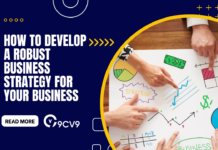









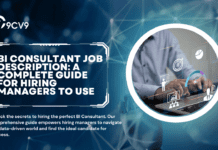





![Writing A Good CV [6 Tips To Improve Your CV] 6 Tips To Improve Your CV](https://blog.9cv9.com/wp-content/uploads/2020/06/2020-06-02-2-100x70.png)


